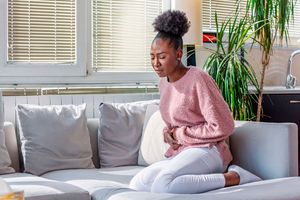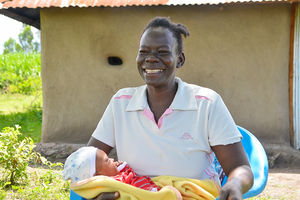Depression during menses: Why it happens and what to do

The condition affects three to eight per cent of women in the reproductive age group.
What you need to know:
- All world over, 70-90 per cent of women of reproductive age have one or more signs of physical discomfort or emotional symptoms in the luteal phase (the post-ovulatory phase) of their menstrual cycle.
Aysha* woke up in a dark room with beeping alarms. She was covered in a tangle of tubes and had an oxygen mask on. The TV on the wall across from her bed was flickering on silent. She did not know where she was but when she turned her head, she found her mum seated beside her bed, sleeping at an uncomfortable angle.
Her throat was parched and her tongue felt swollen in her mouth. She cleared her throat, startling her mum into tears of relief. Aysha could tell she was in the hospital, but she was struggling to remember why she was there in the first place, and for how long. All she recalled was getting into a fight with her brothers as a result of their teasing, calling her Cruella de Vil; the nasty character from their all-time favourite movie, the 101 Dalmatians. Boy, did she hate the characterisation!
Later that morning, Aysha was transferred from the high dependency unit to the ward. In the privacy of her room, her mum finally told her what had transpired. Aysha had nearly taken her life, having swallowed a bunch of her mum’s sleeping pills. Her mother blamed herself for having them around in the first place, but she was also distraught that her daughter had reached a point where she felt she had no other choice but to end her life.
True, mother and daughter disagreed a lot, like any other household with a young adult woman who has just finished college and is exercising her freedoms. Aysha and her twin brothers had lost their dad in a grisly accident at a young age; and though struggling with the sudden state of widowhood her mother found herself in, she had tucked away her own broken heart to raise her three children.
As Aysha got to teenage, she would have the worst of pre-menstrual mood, which somehow managed to actually get worse with age. Her brothers would literally play hide and seek with her during these days. She would pick a fight out of the blues, where she was bound to say some hurtful words, but eventually be the one to end up locked up in her room sobbing hysterically for being so mean.
Once her periods ended, Aysha was back to being the family darling. She was the awesome daughter who took up a lot responsibility around the home, minding her brothers and making things easier for mum. She was the amazing big sister who would look out for the boys, attend their school events, their biggest cheerleader and disciplinarian.
Because the good days far outweighed the bad, everyone learnt to cope with her moods without noting just how much they were hindering her social interactions. She would withdraw from people to avoid confrontation and would even miss school on some of these days. She would stay in bed all day, not wanting to be disturbed. She’d eat alone in the room, but she preferred to skip meals.
Aysha did not understand what was happening to her; but she knew it was not comfortable. She had a perfectly regular 28-day menstrual cycle. For the most part, she was fine. But on the last week before her menses started, the downward spiral would set in. At first, she would be moody and combative, but with time, she noted her mood would be so low, with loss of sense of self-worth. In the recent past, she had started having thoughts of self-harm; most often within a day or two of the period starting.
Once menses showed up, despite the pain they came with, the nausea, vomiting and diarrhoea that accompanied them, especially on the first day, the dark cloud hanging over her would begin to lift. By the time she was on her fourth and last day of menses, she would be back to her usual self. This mad cycle is what made it hard to confide in her mother about the dark thoughts that were brewing in her head. She was slowly brewing self-doubt, wondering whether she was losing her marbles.
On the fateful day, she was able to finally recall how, after another tiff with the twins, she had sobbed herself to sleep but woke up to insomnia at about 2am. She recalled her mother kept some sleeping pills in the medicine cabinet. She got the bottle and while staring at pills, got the idea to end her misery and that of her family by removing her sorry self from the equation completely. This is how she ended up in the emergency department in coma from all the benzodiazepine tablets she had swallowed.
By the time she was stable enough to meet the psychiatrist, she was in the good phase of her cycle and open to exploring her recurring situation with the good doctor. Aysha was so relieved to put a name to the madness. She was diagnosed with Premenstrual Dysphoric Disorder (PMDD).
Also known as Luteal Phase Dysphoric Disorder, this is a condition that was largely unacknowledged for decades, only being recently recognised and included in the Diagnostic and Statistical Manual of Mental Disorders, DSM-V, in 2013. This is despite affecting three to eight per cent of women in the reproductive age group.
All world over, 70-90 per cent of women of reproductive age have one or more signs of physical discomfort or emotional symptoms in the luteal phase (the post-ovulatory phase) of their menstrual cycle. For many, these may not be remarkable, but a whopping 20-40 per cent of menstruating women will experience premenstrual syndrome symptoms that are bothersome enough to interfere with daily activity, be it work or school.
With a strong genetic basis, PMDD is thought to occur in women with a normal hormonal circuit between the brain and the ovaries, with the expected rise and fall of the reproductive hormones in the body. However, these women and girls have an altered response to this rise and fall of the hormones, causing the brain chemical, serotonin, that is responsible for mood, behaviour, memory, and gastrointestinal function to drop significantly, explaining the altered mood.
Patients with PMDD manifest a variety of symptoms that exclusively occur in the period after ovulation but before the start of the period, the luteal phase, and disappear during the rest of the cycle.
These include mood swings, sudden sadness or tearfulness, increased sensitivity to rejection, irritability and increased interpersonal conflicts, depressed mood, hopelessness, anxiety, loss of concentration, lack of energy, change in appetite, food cravings, insomnia or hypersomnia, breast tenderness, muscle pain, bloating, or weight gain.
Treatment of PMDD requires a team approach, with the gynaecologist, the psychiatrist and the psychologist at the core of it. Care includes lifestyle modification, considering exercise, weight management, dietary adjustments, and avoiding alcohol and tobacco use. There is need for pain medication for those with severe period pain.
Antidepressant medication may need to be prescribed for some patients, alongside cognitive behaviour therapy, to empower them to handle the symptoms better. Various hormone treatments are also part of the arsenal of options offered, especially where they are used to induce a period holiday, thereby avoiding the hormonal drop that triggers the symptoms in the first place.
Where all else fails, special medications may be used to induce a temporary state of menopause, to side-step the rise and fall of the hormones in the menstrual cycle. In extreme cases, radical surgery to do away with the uterus and the ovaries that make the hormones has been considered.
Aysha is finally thriving. She has her life back, and with the help of hormones, antidepressants and therapy, Cruella De Vil has finally been vanquished!
Dr Bosire is an obstetrician/ gynaecologist





